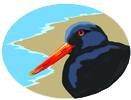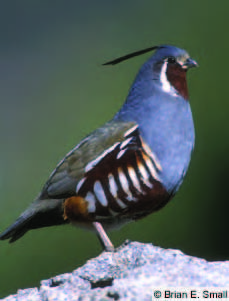I have to admit that I only recently realized that we have another quail in our county. The beautiful Mountain Quail is found in the dense brush at high elevations along the edges of woodlands, forests, foothills and meadows. It has been called the most handsome quail and the largest at 11 ˝ inches. It has a long straight head plume instead of the pompadour of the California Quail. Its chestnut throat patch is lined by greenish white. Its chestnut sides have long white lines on them. Its chest is brown and gray and it has a very short tail. Juveniles have shorter head plumes and a white chin.
Mountain Quail live in small groups, or ‘coveys’ of three to twenty. They are very cautious and quickly disappear into the underbrush. Mountain Quail prefer to walk and take to flight only as a last resort. In the spring they nest from 1,500 to 10,000 feet. In the fall they walk to lower elevations, especially in the Sierra Nevadas. Some are known to walk 20-40 miles. In the winter they feed on nuts, seeds and berries. In the spring they return to higher elevations and eat leaves, buds and scratch up bulbs and insects. They will also climb trees to glean food.
The Mountain Quail’s nest is a well-concealed shallow depression on the ground. It is hidden under grass and shrubs, at the base of a tree or against a log. It is lined with grass, leaves, needles and feathers. Nests are often near paths and roads and usually close to water. She lay nine to ten buff-white eggs and incubates them for two weeks. Young are able to get up and run in soon after hatching and are able fly in two weeks.
Mountain Quail photo Brian E Small


